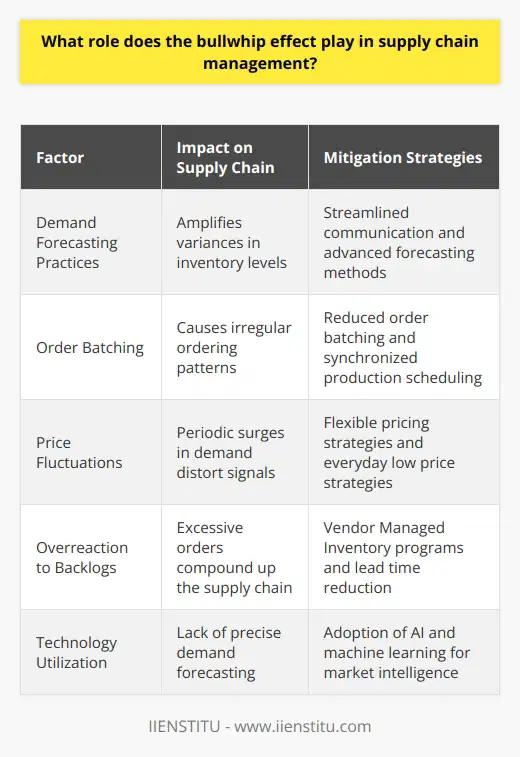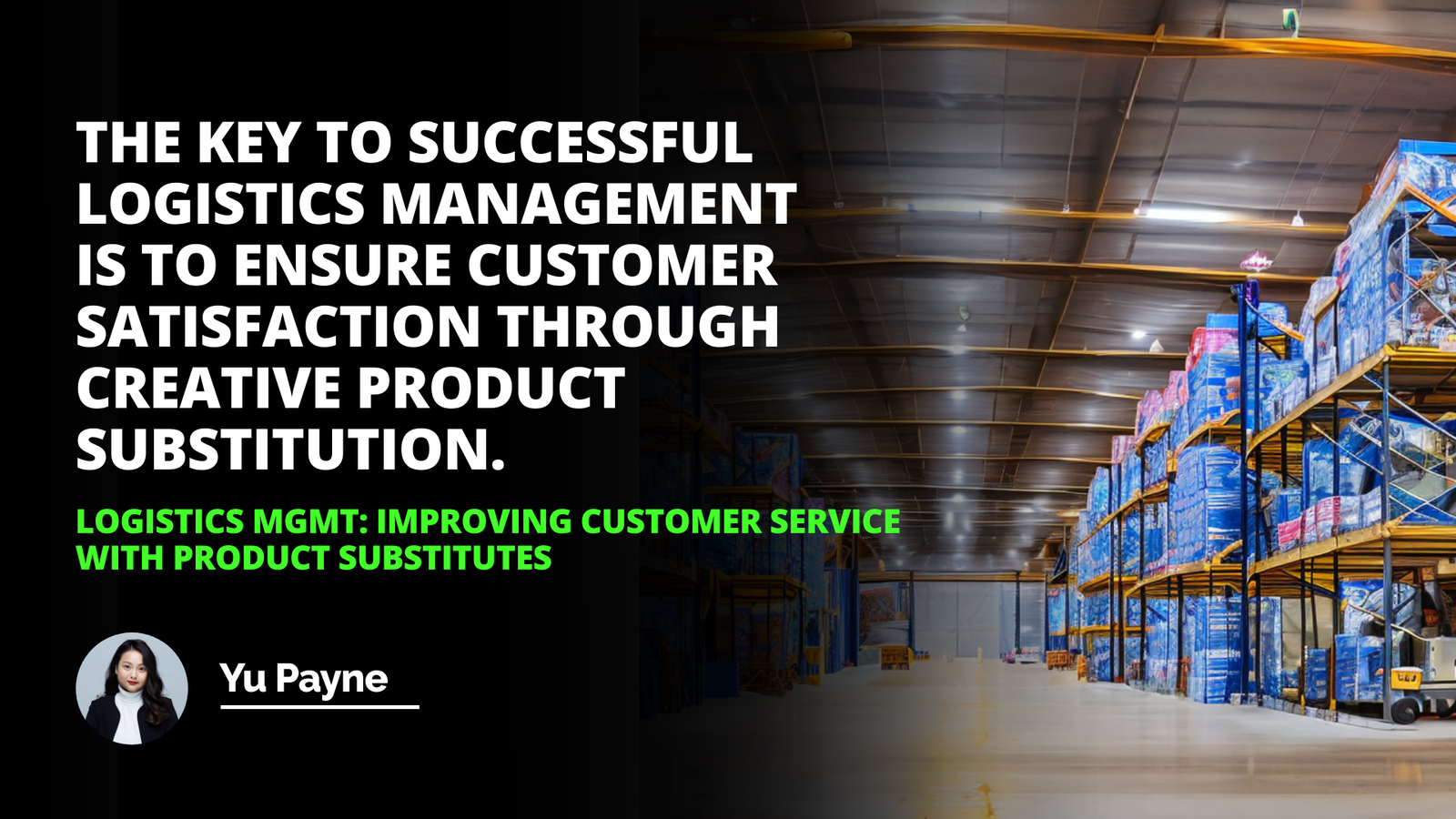
I still remember the day when I was anxiously waiting for a critical shipment of components for my small electronics business. It was a chilly Tuesday morning, and the success of our latest product launch hinged on the timely arrival of these parts. The supplier had assured me that the delivery would arrive on schedule, as it always had in the past. However, that day, the delivery didn't show up. Hours turned into days, and my stress levels soared. Not only did we have to postpone the launch, but we also faced disappointed customers and increased costs. This experience taught me firsthand the profound importance of delivery consistency in business operations.
Introduction
Definition of Delivery Consistency
Importance of Delivery Consistency
Impact of Inconsistent Delivery
Conclusion
Understanding Delivery Consistency
At its core, delivery consistency refers to the ability of a supplier to deliver products or materials to a buyer within the agreed-upon timeframe consistently. It's not just about making a delivery on time once or twice; it's about maintaining that reliability over the long haul. The consistency is often measured as a percentage of orders met within the agreed timeframe. For instance, if a supplier fulfills 97 out of 100 orders on time, they boast a delivery consistency of 97%. Measuring this over extended periods provides businesses with a clearer picture of a supplier's reliability.
In the world of supply chain management efficiency, delivery consistency plays a pivotal role. It acts as a barometer for the efficiency and effectiveness of a supplier's logistics chain. A consistent delivery schedule means that the supplier's processes, from production to shipping, are streamlined and well-coordinated.
The Importance of Delivery Consistency
The significance of delivery consistency cannot be overstated. For businesses relying on suppliers, consistent delivery times are the backbone of operational planning and inventory management strategies. Here are some reasons why delivery consistency is so crucial:
Best Transportation Modes For Optimizing Logistics Management
Optimization Of Multi-modal Transport İn Global Supply Chains
1- Customer Satisfaction in Logistics: Customers today expect products and services to be delivered promptly. In a marketplace teeming with options, any delay can lead to customer dissatisfaction. Consistent delivery ensures that customer expectations are met, leading to higher satisfaction and loyalty.
Achieving Reliable Delivery Performance in Logistics Management
Unleashing the Power of Logistics for 30-Minute Pizza Delivery
Optimizing Logistics Management: Transportation Modes & Costs
Exploring the Impact of Real-Time Tracking and Tracing in Supply Chain Operations
2- Efficient Inventory Management: When a supplier delivers consistently, businesses can better manage their inventory levels. This means less money tied up in stock and more liquidity for other operations. It also reduces the risk of overstocking or stockouts.
3- Operational Planning: Consistency allows businesses to plan their operations more effectively. Production schedules, marketing campaigns, and sales forecasts all hinge on the availability of products. When deliveries are consistent, planning becomes more accurate and efficient.
4- Cost Savings: Inconsistent deliveries often result in expedited shipping costs, overtime for staff, or even lost sales. Maintaining a consistent delivery schedule helps avoid these unnecessary expenses.
I recall another instance when, working with a new supplier, we experienced fluctuations in delivery times. One week, shipments would arrive early; the next, they were delayed. This inconsistency wreaked havoc on our production schedules and made it nearly impossible to predict inventory needs. We were either overstocked, causing storage issues, or scrambling to fulfill orders, leading to overtime expenses. It became clear that without delivery consistency, our logistics chain optimization techniques were rendered ineffective.
Consistency is the key to success in logistics management, and 97% delivery consistency is the ultimate goal.
The Impact of Inconsistent Delivery
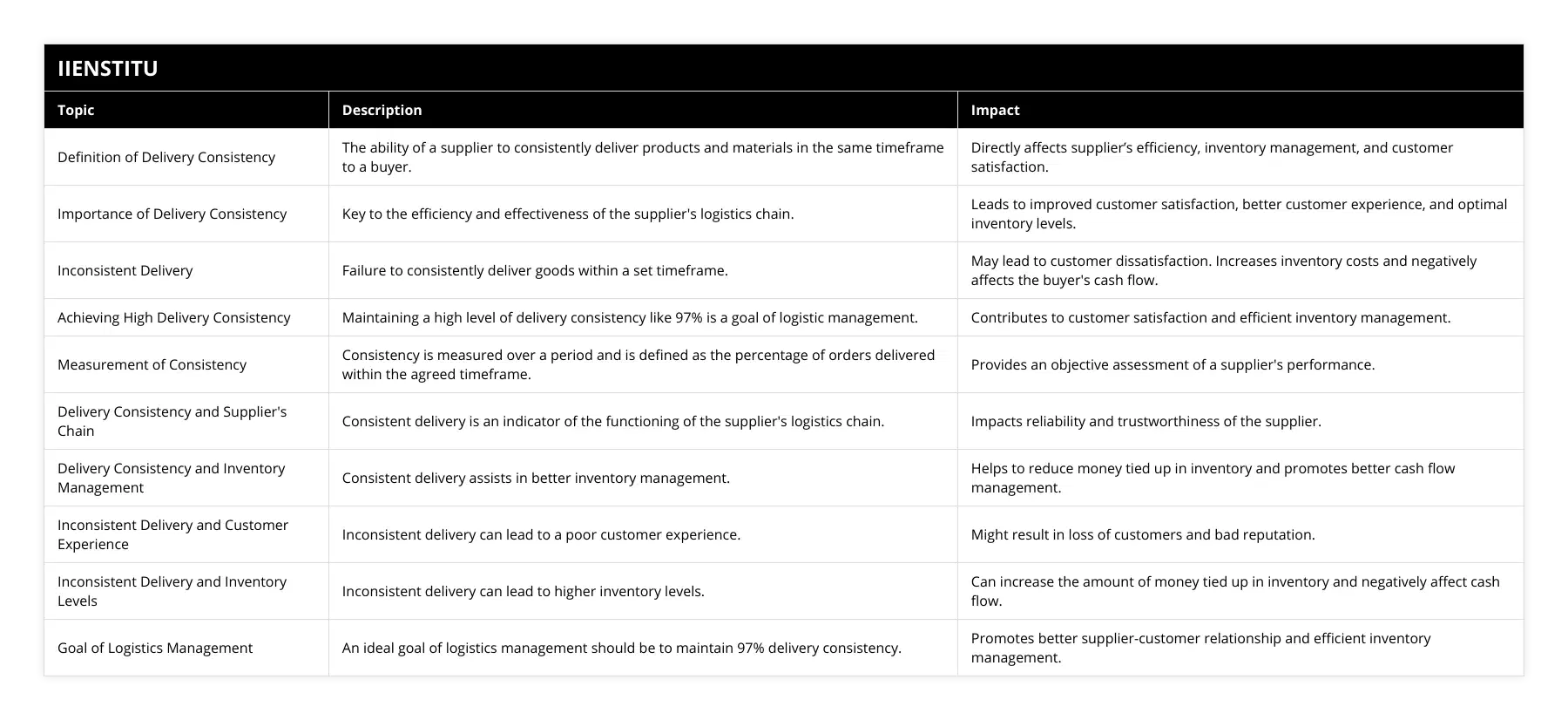
The effects of inconsistent delivery on business are profound and far-reaching. Here's how inconsistent delivery can negatively impact a business:
Customer Dissatisfaction: As mentioned earlier, delayed or inconsistent deliveries can frustrate customers. In today's fast-paced market, customers have little patience for delays, and a single bad experience can drive them to competitors.
Increased Inventory Costs: To buffer against late deliveries, businesses might overstock inventory. This ties up capital that could be used elsewhere and increases storage costs.
Disrupted Production Schedules: For manufacturers, late deliveries of raw materials can halt production lines, resulting in downtime and increased labor costs.
Damaged Reputation: Consistently failing to deliver on time can tarnish a company's reputation. Word spreads quickly, and it can be challenging to regain trust once it's lost.
Let me share a story from a colleague in the automotive industry. They relied on a supplier for specific parts essential to their production line. Due to inconsistent deliveries, they faced multiple production halts. Each halt cost the company thousands of dollars per hour. Not only did this impact their bottom line, but it also strained relationships with their clients who were waiting for the finished vehicles.
Strategies to Improve Delivery Consistency
Understanding the importance of delivery consistency is one thing, but implementing strategies to improve it is another. Here are some effective strategies businesses can adopt:
1- Implementing the Critical Path Method Project Management Strategy: The critical path method project management strategy is a step-by-step project management technique for process planning that defines critical and non-critical tasks. By identifying the longest stretch of dependent activities and measuring the time required to complete them from start to finish, businesses can optimize their processes to ensure on-time deliveries. This method helps in pinpointing potential bottlenecks in the supply chain and addressing them proactively.
2- Investing in Technology: Utilizing advanced logistics software can help track shipments in real-time, predict potential delays, and optimize routes. Automation tools can also help streamline ordering processes and inventory management, reducing human error.
3- Strengthening Supplier Relationships: Open communication with suppliers is vital. By establishing strong relationships, businesses can work collaboratively to address any issues that might affect delivery times. Regular meetings and updates can ensure both parties are on the same page.
4- Diversifying Supplier Base: Relying on a single supplier can be risky. By diversifying the supplier base, businesses can mitigate risks associated with delays from one source.
5- Continuous Monitoring and Feedback: Regularly monitoring delivery performance and providing feedback to suppliers can help maintain high standards. Setting clear expectations and KPIs can drive improvements in delivery consistency.
An acquaintance in the retail sector once shared how they improved their delivery consistency dramatically by adopting these strategies. They began by implementing the critical path method to map out all essential steps in their supply chain. This highlighted areas where delays were most likely to occur. By addressing these weak points and investing in better communication tools with their suppliers, they saw a significant improvement in their delivery times.
Personal Reflections
Looking back at my own experiences, I realize how much smoother operations run when delivery consistency is maintained. There was a time when we decided to overhaul our supply chain processes. We incorporated several of the strategies mentioned above, especially focusing on better communication with our suppliers and investing in technology. The results were astounding. Not only did we achieve a 99% delivery consistency rate, but we also saw an increase in customer satisfaction and a decrease in inventory costs.
I remember one instance where a customer personally thanked us for our prompt delivery during a peak season. They mentioned how they had faced delays with other suppliers but appreciated our reliability. Moments like these underscore the importance of delivery consistency not just in terms of operational efficiency but also in building strong customer relationships.
Conclusion
In the complex world of supply chain management, delivery consistency emerges as a critical factor that can make or break a business. It affects everything from customer satisfaction to inventory management and overall operational efficiency. By understanding its importance and implementing strategies like the critical path method project management strategy, businesses can significantly improve their delivery performance.
It's not an overstatement to say that consistency is the key to success in logistics management, and achieving a 97% delivery consistency rate should be the ultimate goal for any organization. Just as I learned from my early experiences, maintaining high delivery consistency is essential for building trust with customers, optimizing operations, and staying competitive in today's fast-paced market.
In a world where customers expect nothing less than perfection, businesses cannot afford to falter in their delivery commitments. By prioritizing delivery consistency, companies can ensure they not only meet but exceed customer expectations, paving the way for long-term success and growth.
References
1- Chopra, S., & Meindl, P. (2016). Supply Chain Management: Strategy, Planning, and Operation. Pearson Education.
2- Kerzner, H. (2017). Project Management: A Systems Approach to Planning, Scheduling, and Controlling. Wiley.
3- Simchi-Levi, D., Kaminsky, P., & Simchi-Levi, E. (2008). Designing and Managing the Supply Chain: Concepts, Strategies, and Case Studies. McGraw-Hill.
4- Waters, D. (2007). Supply Chain Risk Management: Vulnerability and Resilience in Logistics. Kogan Page Publishers.
5- Heizer, J., Render, B., & Munson, C. (2017). Operations Management: Sustainability and Supply Chain Management. Pearson Education.
Related Course
For those interested in diving deeper into supply chain optimization and the strategies discussed, I highly recommend exploring academic courses on supply chain management and logistics. These courses provide valuable insights into managing complex supply chains effectively.
Frequently Asked Questions
What strategies can be implemented to achieve 97% delivery consistency in logistics management?
Logistics management is a complex field that requires a high degree of consistency to ensure customer satisfaction. Achieving a 97% delivery consistency rate is difficult, but it is possible with the right strategies in place. This article will discuss some methods that can be implemented to help organizations reach this goal.
First, organizations must prioritize customer satisfaction. This means that they should focus on providing accurate and timely deliveries and excellent customer service. To do this, they should strive to improve their processes, such as creating a streamlined order management system and implementing quality assurance protocols. Additionally, they should focus on training personnel to ensure they are knowledgeable and capable of providing excellent service.
Second, organizations should invest in technology to improve their logistics operations. This includes investing in advanced tracking systems, automated processes, and data analytics. These technologies can help organizations improve their delivery accuracy and speed. Additionally, they can help organizations keep track of their inventory and ensure that they are not over or under-stocked.
Third, organizations should create a system of incentives for their personnel. This includes providing rewards for exceptional service and performance and holding employees accountable for any mistakes or delays. Additionally, organizations should strive to create a culture of continuous improvement in which employees are encouraged to work together to find better ways of doing things.
Finally, organizations should create a network of reliable suppliers and partners. This includes finding reliable carriers to help ensure timely and accurate deliveries. Additionally, organizations should make sure they are working with vendors who have the resources and capacity to meet their demands.
By implementing these strategies, organizations can help ensure that they reach a 97% delivery consistency rate. This is essential for customer satisfaction and can help organizations stand out in a competitive market.
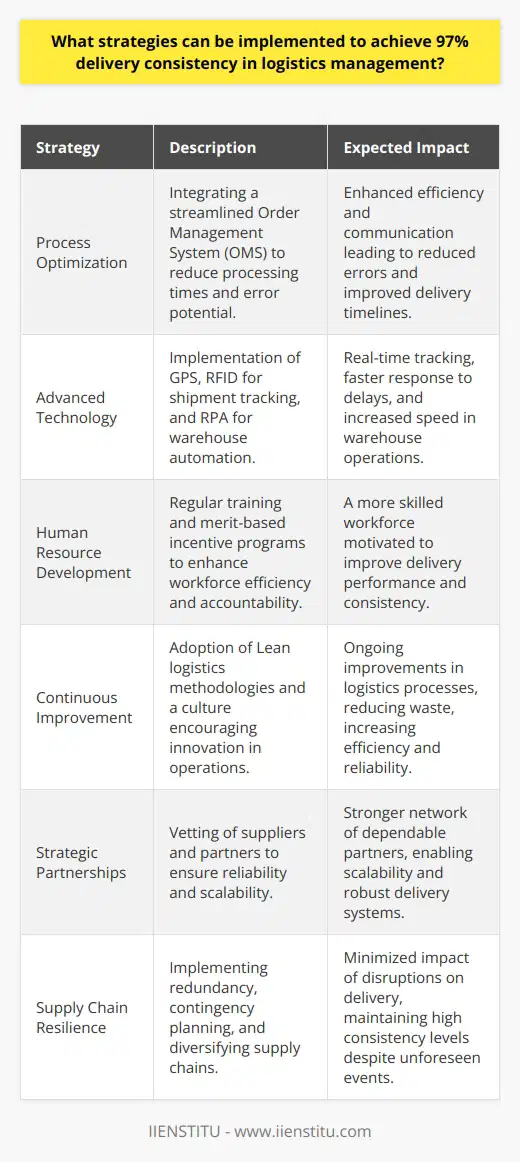
How does delivery consistency impact customer satisfaction?
The delivery of a product or service is a critical factor in determining customer satisfaction, as it reflects the overall quality of the experience. Consistent delivery is essential to ensure customer satisfaction, as it allows customers to trust that they will receive the product or service promptly and reasonably.
The impact of delivery consistency on customer satisfaction can be seen in several ways. Firstly, consistent delivery helps to build customer trust, as customers will be reassured that the product or service will arrive as expected. This trust can lead to increased customer loyalty, as customers will be more likely to return to the same business for future purchases. Additionally, consistent delivery helps to create a positive customer experience, as customers will not have to worry about unexpected delays or issues.
Furthermore, consistent delivery can also have a positive effect on customer engagement. Customers who receive their products or services on time are more likely to provide feedback, share their experiences, and engage with the brand. This helps to create a positive customer experience, as customers will be more likely to recommend the product or service to others.
Finally, consistent delivery can help to increase customer satisfaction by reducing customer effort. Customers who receive their products or services as expected will not have to put in extra effort to track their order or request a replacement. This can increase customer satisfaction, as customers will feel more secure in their purchases.
In conclusion, delivery consistency is an essential factor in determining customer satisfaction. A consistent delivery helps to build customer trust, increases customer engagement, and reduces customer effort, all of which contribute to a positive customer experience and increase customer satisfaction.
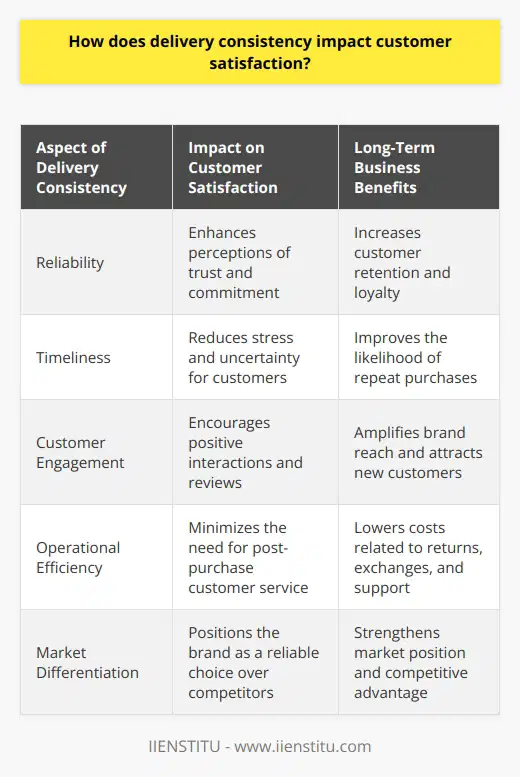
What are the potential risks associated with inconsistent delivery?
When it comes to the delivery of goods and services, consistency is essential. However, inconsistent delivery can lead to various risks that can have a detrimental effect on a business's customer experience, reputation, and profitability. This article will discuss the potential risks associated with inconsistent delivery and how companies can mitigate them.
First, inconsistent delivery can lead to a decrease in customer satisfaction. Customers expect their orders to be delivered on time, and if they are not, they may be less likely to return in the future. Furthermore, poor delivery can lead to customer complaints and negative reviews, damaging a company's reputation.
Second, inconsistent delivery can lead to higher costs. If orders are not delivered on time, businesses may need to pay additional fees to expedite delivery. This can lead to higher prices and a decrease in profitability. Additionally, if goods are not delivered on time, businesses may miss out on potential sales.
Third, inconsistent delivery can lead to a decrease in customer loyalty. Customers expect a certain level of consistency, and if it is not met, they may not remain loyal to a business. This can lead to a decrease in long-term revenue and customer retention.
Finally, inconsistent delivery can lead to legal risks. For example, if orders are not delivered on time, businesses may be liable for breach of contract and be subject to legal action.
In order to reduce the risks associated with inconsistent delivery, businesses should ensure that they have reliable processes in place. They should also partner with reliable delivery services and ensure that their customers are adequately informed about delivery timelines. Additionally, businesses should track customer feedback and promptly address any issues. By taking these steps, companies can reduce the potential risks associated with inconsistent delivery and ensure that their customers receive their orders on time.
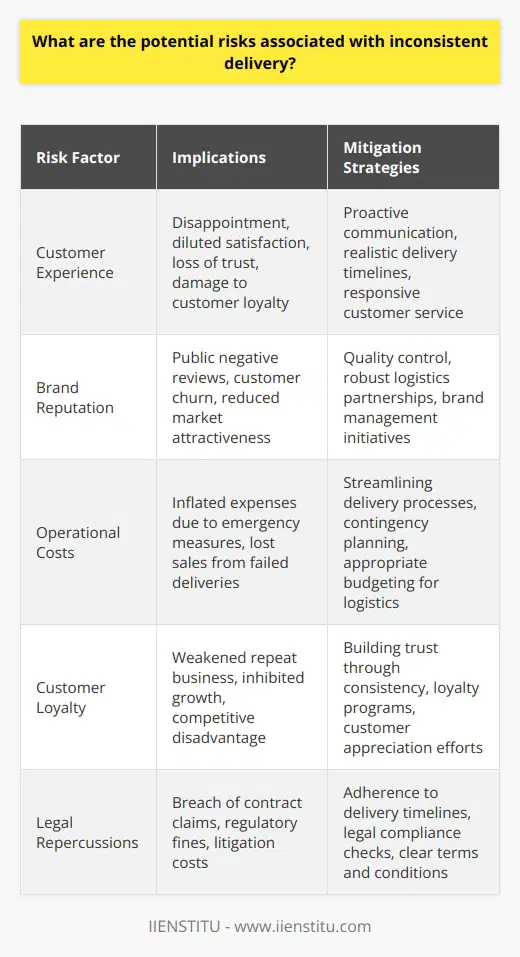
What are the key areas for improvement in logistics operations?
Key Area 1: Supply Chain Visibility
One critical area for improvement in logistics operations is enhancing supply chain visibility. Supply chain visibility refers to the transparency and accessibility of information among all actors in a logistics network, ensuring seamless communication and real-time data sharing. By implementing a centralized data management system, companies can significantly reduce errors, streamline communication, and improve operational efficiency.
Key Area 2: Demand Forecasting
Another essential area for improvement is demand forecasting, which empowers businesses to make informed decisions based on anticipated demands. With the incorporation of advanced analytics technologies such as artificial intelligence and machine learning, enterprises can improve their predictions and adjust their supply chain strategies accordingly. This leads to reduced inventory costs, optimized warehouse management, and improved customer satisfaction.
Key Area 3: Transportation Optimization
To further enhance the logistics operations, transportation optimization should be considered a vital component. This implies adopting strategies to optimize route planning, consolidate shipments, and select the most cost-efficient transportation methods. By focusing on transportation optimization, companies can significantly reduce operational expenses, minimize transit times, and cut down on greenhouse gas emissions.
Key Area 4: Technological Integration
Technological integration is another key area that calls for improvement in logistics operations. By adopting cutting-edge technologies such as GPS, radio frequency identification (RFID) systems, and automated loading and unloading devices, logistics companies can significantly improve their productivity and operational efficiency. Furthermore, embracing digital solutions like supply chain management software and warehouse management systems can aid in streamlining processes and reducing human error.
Key Area 5: Risk Management
Lastly, improving risk management practices is essential for robust and resilient logistics operations. By employing a proactive approach towards identifying potential risks and implementing mitigation strategies, organizations can improve their supply chain resilience and minimize disruptions. For instance, companies should create and maintain a risk register, establish contingency plans, and continuously monitor their performance against pre-defined risk indicators.
In conclusion, the improvement of logistics operations should primarily focus on enhancing supply chain visibility, demand forecasting, transportation optimization, technological integration, and risk management. By addressing these key areas, companies can substantially strengthen their logistics performance and secure a competitive edge in the market.
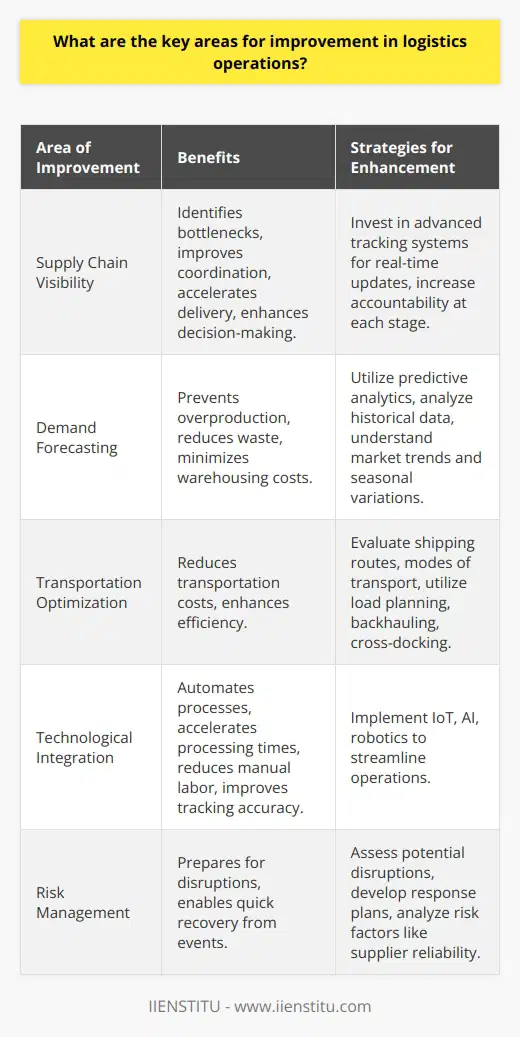
How can you facilitate effective and efficient logistics operations?
Strategic Planning and Collaboration
To facilitate effective and efficient logistics operations, one must engage in strategic planning and collaboration. This includes the assessment of supply chain processes, appropriate choice of transportation, and fostering effective communication across all stakeholders involved. Through these efforts, logistics managers can allocate resources more efficiently, optimize transportation routes, and share important information, resulting in a streamlined and agile supply chain.
Supply Chain Integration
Integration of the supply chain is also crucial in achieving effective logistics operations. By incorporating the use of integrated technologies such as Enterprise Resource Planning (ERP) systems, logistics managers can obtain a comprehensive view of the supply chain, combining information from various sources into a single platform. This holistic perspective allows for more informed decision-making, better coordination of resources, and ultimately leads to an enhanced ability to meet consumer demands in a timely and cost-effective manner.
Continuous Process Improvement
Logistics operations must adapt to changing market conditions and the evolving needs of its customers, therefore implementing continuous process improvement is essential. By regularly monitoring processes, logistics managers can identify patterns, inefficiencies, and potential risks. Lean management principles, such as Six Sigma, can be adopted to drive improvements, ensuring that logistics operations remain highly effective and adaptive to market dynamics. Ultimately, this will lead to an improvement in overall cost, quality, and delivery performance.
Risk Management and Contingency Planning
Efficient logistics operations require a proactive approach to managing risks, which encompasses both the identification and mitigation of potential disruptions within the supply chain. Implementing risk management strategies such as supplier diversification, inventory management, and scenario planning will allow for the early detection of potential issues and expedite response and recovery. In conjunction with this, having a business continuity plan in place ensures that logistics operations remain resilient and able to deliver on its promises irrespective of unforeseen external factors.
Investment in Human Resources and Training
Lastly, investment in human resources and training plays a central role in facilitating effective logistics operations. By nurturing a team of highly skilled and motivated professionals, organizations can develop internal capabilities that drive higher performance within logistics functions. Providing ongoing training opportunities, attractive remuneration packages, and a positive work environment will result in a workforce dedicated to delivering excellence in logistics operations.
In conclusion, achieving effective and efficient logistics operations requires a multi-pronged approach that emphasizes strategic planning, collaboration, supply chain integration, continuous process improvement, risk management, and investment in human resources. By proactively addressing these critical areas, logistics managers can drive organizational success by consistently delivering value to customers and stakeholders.

What are the seven R's in logistics management?
Seven R's in Logistics Management
Understanding the Fundamentals
In logistics management, the concept of the seven R's is a well-known guiding principle that assists in successfully catering to customers' needs. These seven R's represent the following:
Right Product
The first R stands for the right product, highlighting the importance of accurately fulfilling customer orders. It ensures that the products delivered correspond to what the customers require, avoiding any discrepancies between their expectations and the end-product.
Right Quantity
The right quantity refers to providing the products in the precise volume requested by the customer. Over or under-supplying products can result in issues such as excess inventory, stockouts, and possible disruption in business operations.
Right Condition
Focused on quality control, the right condition entails delivering products in perfect physical and visual state. Customers should receive items free from damage, handling errors, or packaging concerns, fostering trust in the brand.
Right Place
The right location emphasizes accurately delivering products to the designated location specified by the customer. This aspect ensures efficient use of time and resources, thereby reducing lead times and avoiding logistical errors.
Right Time
Timely delivery forms the basis of the right time concept. It involves ensuring products reach customers at the agreed-upon time, leading to higher satisfaction levels and fostering customer loyalty.
Right Customer
The right customer principle involves accurately identifying and targeting the intended customer base. This aspect helps businesses align their marketing strategies and logistics operations with the desired target audience, thus enhancing their overall market performance.
Right Cost
Lastly, the right cost refers to providing products to customers at an optimum price, balancing profitability and affordability. This aspect ensures customers feel satisfied with their investment, and the company maintains a fair return on investment.
Conclusion
The seven R's in logistics management serve as a comprehensive guide for businesses to assess and improve their supply chain operations. Adhering to these principles will enhance customer satisfaction and fosters sustainable business growth in the long run.
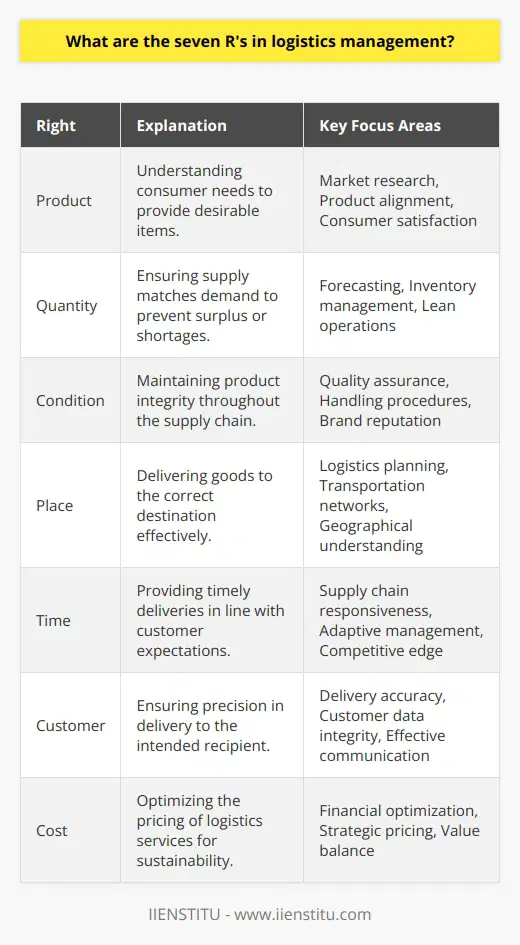
What are the 7 principles of logistics?
**Logistics Principles Overview**
In the field of supply chain management, the adoption of seven universally recognized principles of logistics is essential for the optimal functioning of trading and transportation systems. These principles ensure the effective and efficient management of logistics operations, contributing to business profitability and customer satisfaction. In this paragraph, we will explore these principles one by one, shedding light on their significance.
**Demand Forecasting**
A vital aspect in the realm of logistics, accurate demand forecasting helps organizations predict future customer requirements, guiding their production and inventory planning processes. By developing reliable demand forecasts, businesses can maintain an optimal balance of stock and resources, avoiding waste and facilitating better decision-making.
**Inventory Management**
Managing inventory appropriately is crucial to prevent overstocking and stockouts, which can disrupt logistics operations and lead to financial losses. Companies employ a range of strategies including just-in-time, safety stock, and economic order quantity to efficiently manage inventory levels, minimize costs, and ensure product availability to customers.
**Network Design**
A well-designed logistics network contributes to cost-effective and timely transportation of goods. Organizations strategize the placement of distribution centers, warehouses, transportation routes, and sales outlets to establish a robust network that facilitates the smooth flow of products from suppliers to customers, mitigating potential bottlenecks and delays.
**Transportation Management**
Selecting suitable transportation modes and evaluating route configurations are critical factors in an effective logistics plan. By optimizing transportation decisions, businesses can reduce expenses, improve service quality, and lower the carbon footprint. Sustainable transportation solutions, such as multi-modal transportation and backhauling, contribute to enhanced efficiency and greener operations.
**Information Sharing**
Effective communication, collaboration, and information sharing among all parties involved in the supply chain are necessary for successful logistics operations. Accurate and timely information exchange helps companies resolve issues quickly, make informed decisions, and swiftly respond to changes in demand or internal and external factors.
**Performance Measurement**
Monitoring logistics performance is essential for identifying areas of improvement and determining the efficiency of operations. By implementing key performance indicators (KPIs) and establishing benchmarks, businesses can continuously evaluate their logistics processes, make data-driven decisions, and enhance overall efficiency and effectiveness.
**Continuous Improvement**
Lastly, a progressive approach toward continuous improvement leads to sustained success in logistics. Organizations must embrace change, be proactive in identifying shortcomings, and implement improvement strategies to refine their logistics operations, respond to evolving customer expectations, and stay ahead of the competition.
In summary, by adhering to the seven principles of logistics—demand forecasting, inventory management, network design, transportation management, information sharing, performance measurement, and continuous improvement—organizations can optimize their supply chain management processes and achieve long-lasting success in the competitive global marketplace.
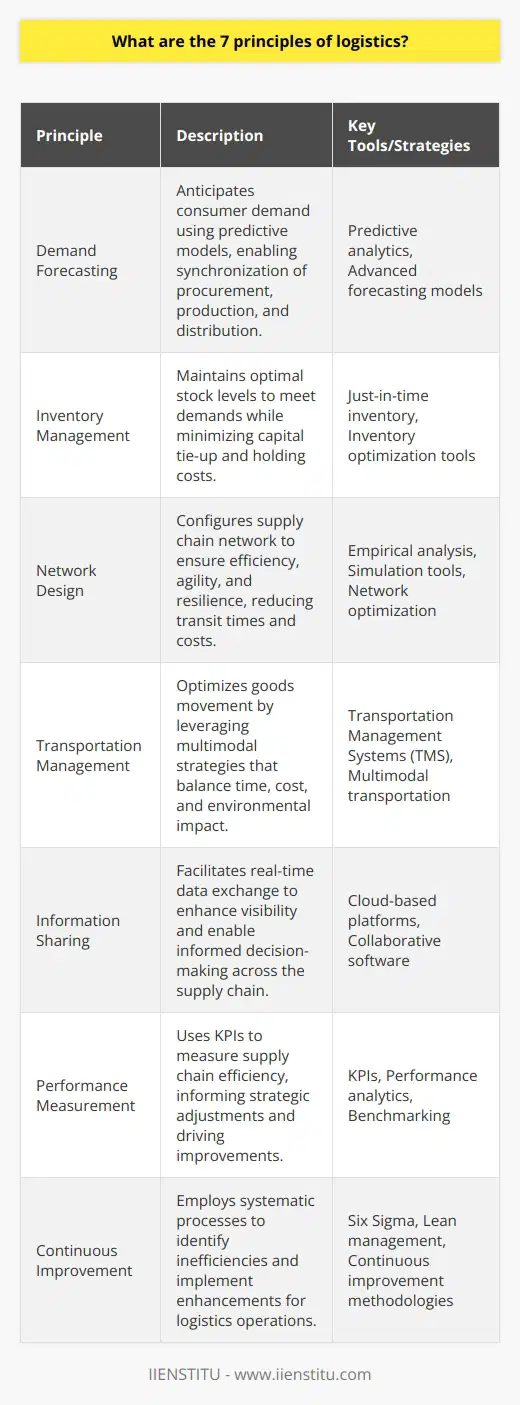
What is delivery reliability rate?
Defining Delivery Reliability Rate
Delivery reliability rate refers to the percentage of orders successfully fulfilled by a supplier or service provider within a specified time frame.
Factors Determining the Rate
Several factors influence delivery reliability rate, including stock availability, lead times, logistical processes, and communication with customers. Careful management and optimization of these factors contribute to higher delivery reliability rates, ultimately improving customer satisfaction.
The Importance of a High Reliability Rate
A high delivery reliability rate is essential for businesses as it reflects their ability to consistently meet customer expectations. An excellent delivery performance can lead to increased customer loyalty, repeat business, and positive word-of-mouth promotion. Moreover, it indicates proactive management along the entire supply chain, ensuring efficient operations and reducing the chances of costly mistakes.
Measuring Delivery Performance
To calculate the delivery reliability rate, businesses need to monitor and compare actual delivery times with planned or promised delivery times regularly. Typically, this metric is expressed as a percentage, with 100% representing total reliability. By tracking and analyzing delivery performance, organizations can identify areas of improvement and make data-driven decisions to enhance their delivery process.
Mitigating Risks
To maintain a high delivery reliability rate, companies must always plan for contingencies and remain adaptable. Managing risks associated with inventory, transport disruptions, and supply chain disruptions is crucial to ensure consistent and reliable delivery service. This can be achieved through effective communication, collaboration with suppliers and partners, and by implementing technology-driven solutions for better inventory management and real-time tracking.
In conclusion, the delivery reliability rate is a critical performance indicator for businesses in today's competitive market. By optimizing various factors, mitigating risks, and continually evaluating performance, companies can strive to achieve high delivery reliability rates and reap the associated benefits.
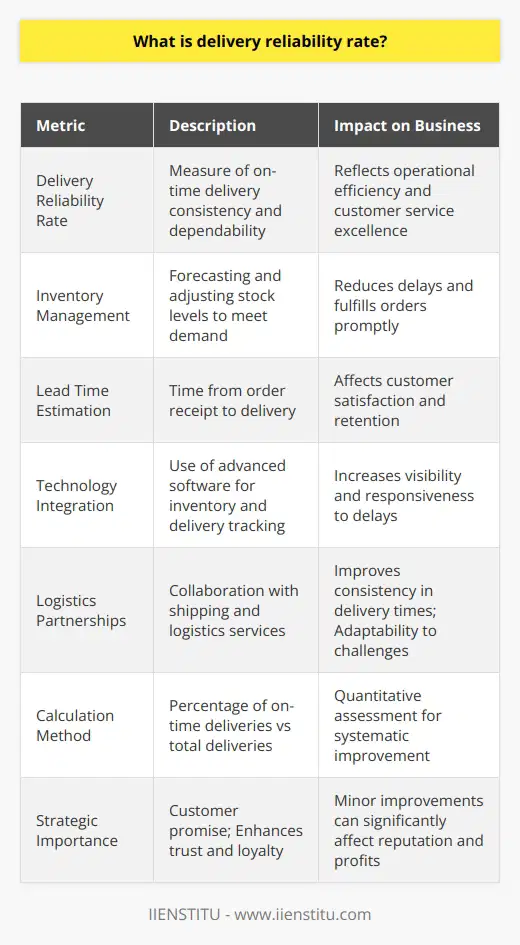
How do you manage logistics operations effectively?
Planning and Coordination
To manage logistics operations effectively, one must focus on planning and coordination of all the activities involved in the supply chain. This encompasses procurement, transportation, warehousing, distribution, and customer service. Implementing efficient processes and utilizing advanced technologies can help streamline these operations and reduce overall costs.
Data-driven Decision-making
Utilizing data analytics to make informed decisions is an essential aspect of managing logistics operations. By analyzing historical and real-time data, managers can identify trends, optimize routes, forecast demand, and monitor the performance of their supply chain. This allows for proactive decision-making and enhanced resource allocation.
Collaboration and Communication
Effective collaboration and communication between all stakeholders - suppliers, carriers, warehouses, and customers - ensures seamless operations and the timely delivery of goods. Establishing clear channels of communication and employing advanced tools like cloud-based platforms can facilitate information sharing and improve the overall efficiency of the logistics process.
Continuous Improvement
The logistics environment is continually evolving, and adopting a mindset of continuous improvement is crucial for businesses to stay competitive. This approach involves identifying areas of inefficiency, setting performance goals, implementing changes, and monitoring progress. Regularly evaluating and adjusting processes allows businesses to adapt to changing market conditions and improve overall performance.
Risk Management
Effectively managing logistics operations also includes minimizing risks and uncertainties associated with the supply chain. This can be achieved through risk assessment, scenario planning, and the establishment of contingency plans. By identifying potential threats and evaluating their impact on the supply chain, managers can take proactive measures to mitigate risks.
Investment in Technology
Investing in advanced technologies, such as automation, machine learning, and the Internet of Things (IoT), can significantly enhance the efficiency of logistics operations. These tools can help optimize routing, track assets, predict maintenance needs, and provide real-time visibility into the supply chain. Embracing digital transformation can give businesses a competitive edge and improve overall operational efficiency.
In conclusion, effective management of logistics operations requires a holistic approach that considers planning, coordination, data-driven decision-making, collaboration, continuous improvement, risk management, and the adoption of advanced technologies. By focusing on these aspects, businesses can optimize their supply chain processes, reduce costs, and better serve their customers.
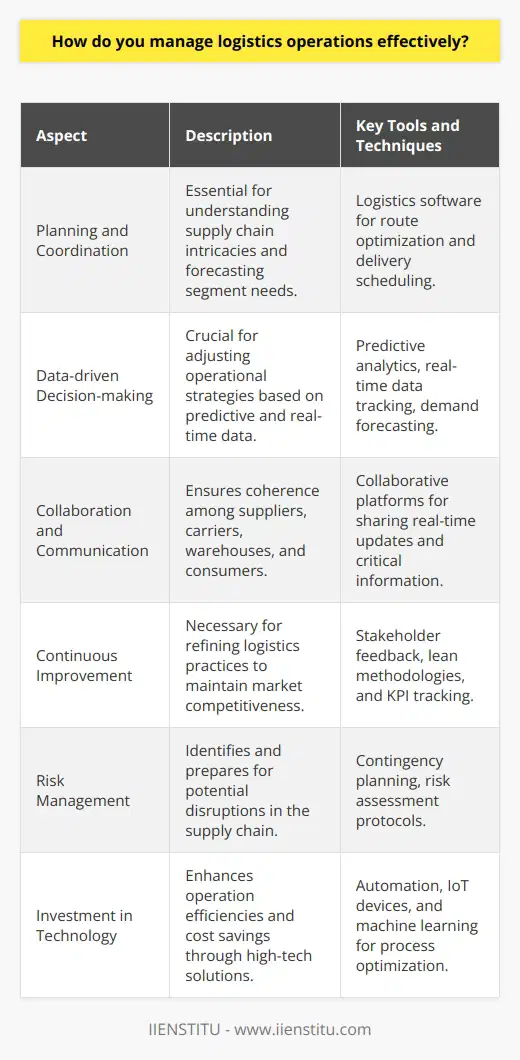
What are the two basic principles of SCM?
**The Principles of Supply Chain Management**
Supply Chain Management (SCM) is a critical aspect of modern business operations. It involves managing the flow of goods and services from raw materials to finished products, ensuring that all aspects of the chain work seamlessly and efficiently. The two fundamental principles of SCM are the demand-driven and integrated supply chain.
**Demand-driven Supply Chain**
The demand-driven principle highlights the importance of understanding and anticipating customer needs. This means focusing on managing inventory based on actual demand rather than simply relying on forecasts or historical patterns. The aim is to minimize lead time, improve product availability, and reduce costs by aligning production, distribution, and procurement activities with customer demand.
To implement this, companies must use accurate demand information to drive decision-making and track changes in consumer preferences. Tools such as Sales and Operations Planning (S&OP) and Advanced Planning and Scheduling (APS) systems can assist in addressing these challenges by closely monitoring demand data and adjusting supply chain activities accordingly.
**Integrated Supply Chain**
The integrated supply chain principle emphasizes the importance of collaboration and coordination among various stakeholders, including suppliers, manufacturers, distributors, and retailers. This approach seeks to create a seamless, transparent, and efficient supply chain by breaking down silos and improving information flow among all parties.
Effective communication is crucial in achieving integration. Companies must share not only demand data but also plans, performance metrics, and potential challenges, enabling a synchronized approach to decision-making. Information technology plays a significant role, with tools such as Enterprise Resource Planning (ERP) systems and Electronic Data Interchange (EDI) facilitating the exchange of data between stakeholders.
Additionally, strategic partnerships and alliances may be developed to foster collaboration, improve reliability, and boost efficiency throughout the supply chain network. These relationships should be based on shared goals and trust, allowing for mutual benefit and long-term success.
In conclusion, the two basic principles of SCM, demand-driven and integrated supply chain, are essential for companies seeking to gain a competitive advantage in today's global business environment. By aligning activities with customer demand and improving collaboration among stakeholders, firms will be better equipped to manage their supply chain processes and overcome the numerous challenges they face.
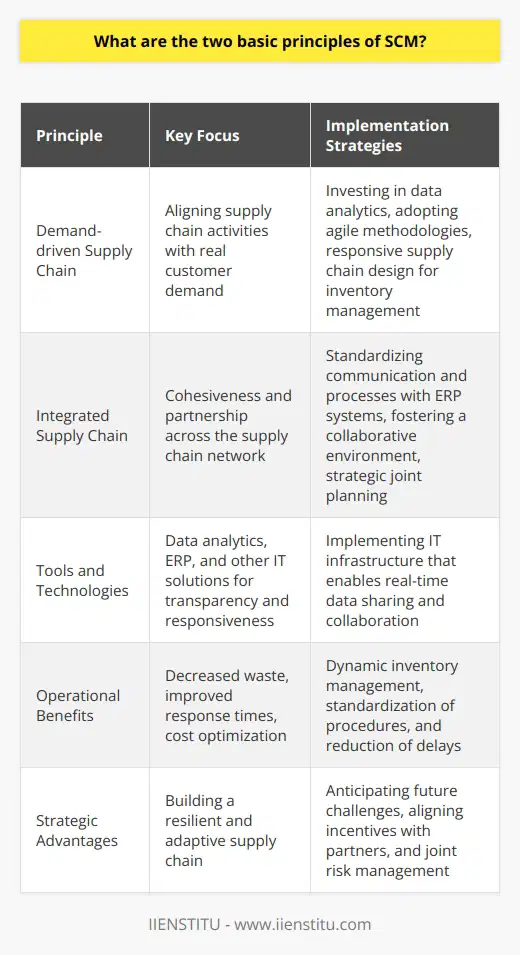
How does the Just-in-Time (JIT) concept influence logistics efficiency?
JIT Impact on Logistics Efficiency
Inventory Reduction
Just-in-Time (JIT) concept greatly influences logistics efficiency by reducing the inventory levels in the supply chain. Manufacturers acquire materials only when they need them for production, hence minimizing the costs associated with storing excess inventory. This allows companies to free up resources for other strategic investments.
Production Synchronization
JIT streamlines production processes by synchronizing the production schedules of manufacturers and suppliers. Efficient collaboration ensures that materials are delivered to manufacturers at the right time, minimizing delays and improving productivity. By enhancing communication between parties, JIT achieves greater efficiency in logistics operations.
Lead Time Reduction
JIT focuses on reducing lead times in the logistic process, speeding up product delivery to customers. Shorter lead times not only enhance customer satisfaction but also improve cash flow for businesses. A faster production cycle allows companies to capitalize on market opportunities and respond more effectively to changes in demand.
Quality Improvement
With JIT, suppliers and manufacturers emphasize delivering quality materials and products. This approach ensures that the entire supply chain conforms to stringent quality standards, leading to fewer defective products and returns. Consequently, better quality management helps in reducing logistics costs and enhancing operational efficiency.
Increased Flexibility
The JIT concept encourages flexibility in the logistics process as it manages fluctuations in demand. By allowing companies to adapt their production levels based on market conditions, they can respond effectively to changing customer requirements. This increased agility can lead to improved logistics performance and overall efficiency.
Conclusion
In conclusion, the Just-in-Time concept significantly influences logistics efficiency in various ways. By reducing inventory levels, synchronizing production, reducing lead times, improving quality, and enhancing flexibility, it allows companies to optimize their operations and achieve greater performance. Implementing JIT principles can lead to substantial cost savings, increased responsiveness to market demands, and ultimately higher customer satisfaction.
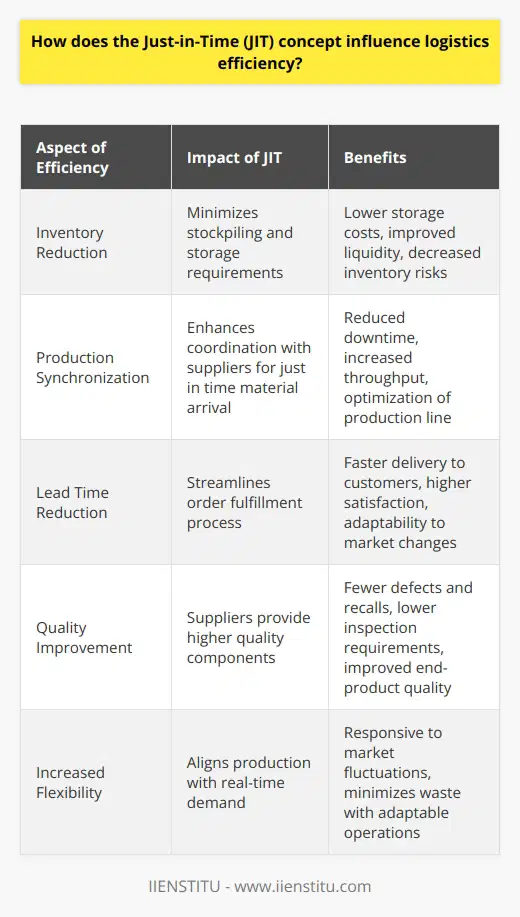
What role does the bullwhip effect play in supply chain management?
Understanding the Bullwhip Effect
The bullwhip effect plays a significant role in supply chain management as it refers to the amplification of demand variability throughout the supply chain. This phenomenon can lead to inefficiencies in inventory management, production schedules, and overall business operations. The bullwhip effect typically results from a lack of information sharing and the misinterpretation of market demand signals by various stakeholders within the supply chain.
Causes of the Bullwhip Effect
Several factors contribute to the bullwhip effect, such as demand forecasting errors, order batching, price fluctuations, and reactive behavior by supply chain partners. Specifically, order batching occurs when retailers and suppliers consolidate orders before passing them up the supply chain, which might lead to uneven order patterns. Seasonal discounts, promotional activities, and special pricing can also cause distorting effects on demand information, leading to higher levels of demand variability.
Mitigation Strategies
To address the bullwhip effect in supply chain management, companies can adopt a variety of measures. It's essential to improve communication and collaboration across supply chain partners by sharing relevant demand information as accurately as possible. For instance, utilizing Electronic Data Interchange (EDI) or cloud-based supply chain management software can provide real-time data access for better decision-making.
Another mitigation approach involves reducing lead times and order batch sizes, as this can help limit the distortion caused by order batching. Supply chain partners should also establish information-sharing systems that enable better demand visibility and accurate forecasting. Additionally, companies can implement Vendor Managed Inventory (VMI) programs, where suppliers control the inventory levels, ensuring the right products are available at the appropriate times.
Enhancing Demand Forecast Accuracy
Improving demand forecast accuracy is crucial in minimizing the bullwhip effect. Firms should adopt advanced forecasting techniques, such as time series analysis, machine learning algorithms, and integration with market intelligence data. These methods can assist in providing a more accurate prediction of future demand patterns and reducing stockouts and excess inventory.
In conclusion, the bullwhip effect poses considerable challenges for businesses by amplifying demand variability in supply chains and causing inefficiencies. To mitigate this phenomenon, companies need to enhance communication and collaboration across supply chain partners, implement information-sharing systems, improve demand forecast accuracy, and adopt strategies such as reducing lead times and order batching. By addressing the bullwhip effect, businesses can optimize their supply chain performance and achieve better overall results.
